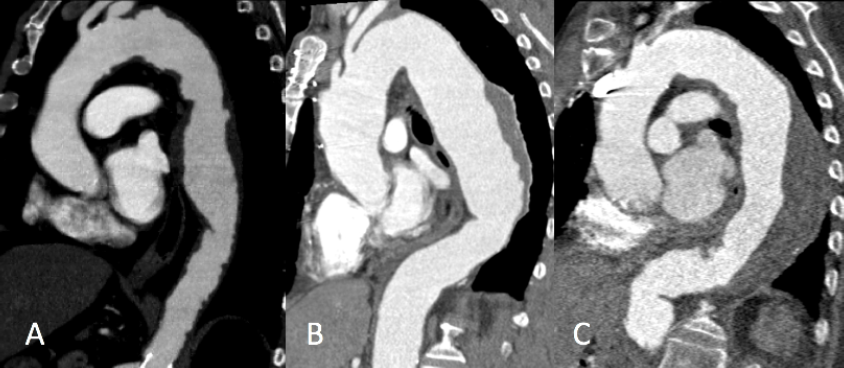Computational Fluid Dynamics in Descending Thoracic Aortic Aneurysm: Tortuosity associated with high Displacement Forces
Viony M. Belvroy, MD1, Rodrigo R. Romarowski2, Joost A. van Herwaarden, MD3, Jean Bismuth, MD, PhD4, Ferdinando Auricchio, PhD5, Frans L. Moll, MD, PhD3, Santi Trimarchi, MD, PhD1.
1I.R.C.C.S. Policlinico San Donato, San Donato Milanese, Italy, 23D and Computer Simulation Laboratory, IRCCS Policlinico San Donato, San Donato Milanese, Italy, 3Department of Vascular Surgery, University Medical Center Utrecht, Utrecht, Netherlands, 4Houston Methodist DeBakey Heart & Vascular Center, Houston, TX, USA, 5Department of Civil Engineering and Architecture, University of Pavia, Pavia, Italy.
OBJECTIVES: Tortuosity comes with higher displacement forces (DF) in the aorta. As the descending thoracic aorta (DTA) is becoming longer and more tortuous with age, it is important to understand the influence of tortuosity on displacement forces in the DTA.
METHODS: Computational Fluid Dynamics was used to measure DF in patients with descending thoracic aortic aneurysm (DTAA). Twenty-nine CT angiography scans were collected and image segmentation was carried out to retrieve their 3D representation. The DTA was divided into four equal zones and there were three different groups of angulation; low (< 30°), moderate (30° - 60°) and high (> 60°), see figure 1, where the DF were measured. The DF was normalized by the aortic wall surface, called the equivalent surface traction (EST).
RESULTS: The EST were not significant in zone 1, 2 and 4. Zone 3, where the angulation usually occurs has significantly higher forces (low: 743 N, moderate: 956 N, high: 2059 N; p = 0.004). These differences are related to the higher sideways direction forces, which are more than two times greater in the high angulation group (low: 5.01 N, moderate: 5.50 N, high 13.21 N; p = 0.009).
CONCLUSIONS: In the lower zones, which are important for the distal landing zone in TEVAR, the displacement forces are significantly higher in the high angulation group. Future studies should look into the risk of these forces related to complications like stent graft migration and spinal cord ischemia when extension of the endograft is necessary to overcome this angulation. 
Back to 2019 Abstracts
